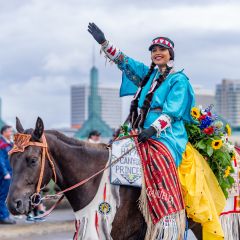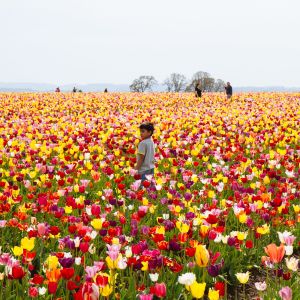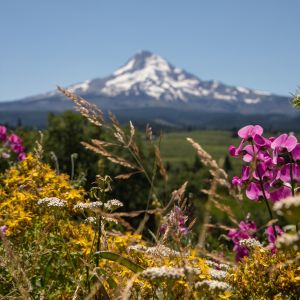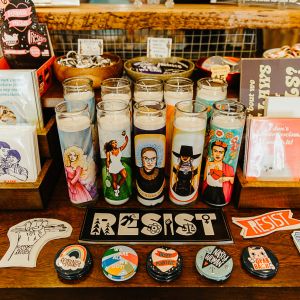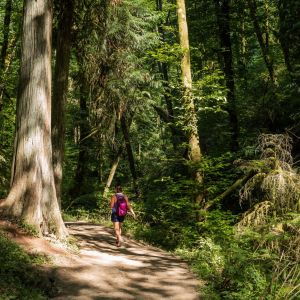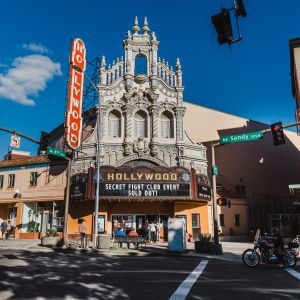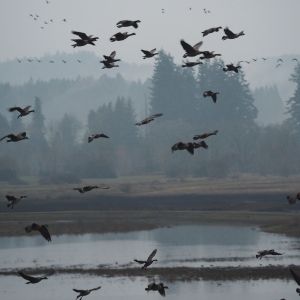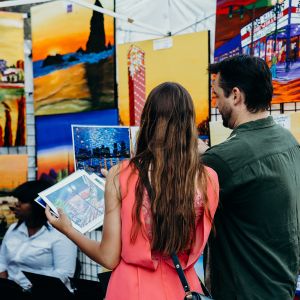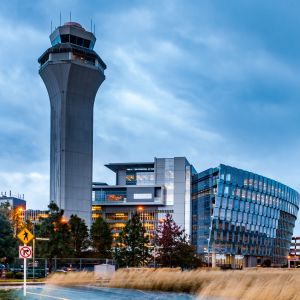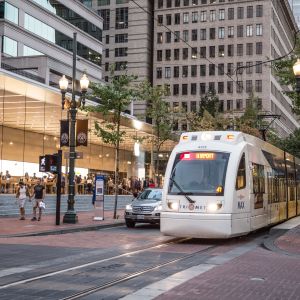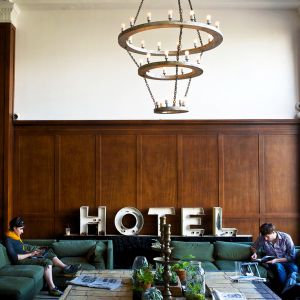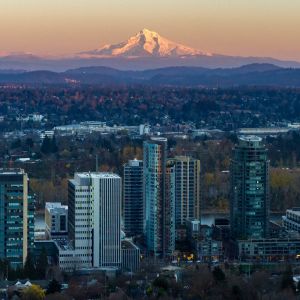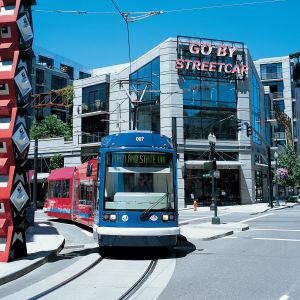Spring in Portland
Portland's energy is irresistible as the city welcomes floral bounty and sunnier days.
Illustration by Subin Yang
A City of Neighborhoods
Portland is known for the vibrancy and uniqueness of its many neighborhoods, each with a distinct sense of place, and — in quirky Portland fashion — spread across six so-called "quadrants."
Locals will tell you that you haven’t truly been to Portland until you’ve connected with our diverse communities.
Visit our neighborhoods page to get acquainted with more than 20 awesome Portland neighborhoods.
North Portland
North Portland sits atop the City of Roses, bordered by the Columbia River to the north, the Willamette River to the southwest and North Williams Avenue to the east. Portland’s so-called “Fifth Quadrant” is a lively patchwork of commercial districts, natural spaces and residential areas. It’s home to some of the city’s most charming neighborhoods, including St. Johns, Mississippi, Williams and Kenton.
Northwest Portland
Northwest Portland stretches from Forest Park in the west to the Willamette River at the east, encompassing the central city’s Old Town Chinatown and Pearl District, Northwest/Nob Hill, Slabtown and miles of wooded hillsides. Its west side is forested and serene; its east side is urban and lively, a vital part of the central city.
Northeast Portland
For shows, sports and big events, Northeast Portland is hard to beat. In addition to being home to the Moda Center and the Oregon Convention Center, Portland’s largest quadrant boasts striking architecture, historic theaters, a variety of public golf courses and other attractions. You’ll also find numerous colorful neighborhoods, including the Alberta Arts District, Hollywood, Lloyd and many more.
Southwest and South Portland
Best known for lively downtown Portland — the compact, walkable heart of the City of Roses — Southwest Portland is also home to Washington Park’s numerous attractions, Goose Hollow’s blend of historic and modern, the small-town charm of Multnomah Village and more. Nearby South Portland is a laid-back river community offering water recreation, low-key urban green spaces and lots of spots to eat, drink and shop.
Southeast Portland
If you’re searching for Portland’s best-known attributes — hip, artsy, quirky, foody — you may find yourself in Southeast Portland. It’s home to some of the city’s liveliest neighborhoods and popular areas for eating and imbibing, like the Hawthorne District, the Central Eastside and the Jade District. Farther out, you’ll find peaceful parks and family-friendly attractions like the Oregon Museum of Science and Industry (OMSI) and Oaks Amusement Park.
Upcoming Events
Check out our events calendar to find fun events and activities around the city.
Earth Day Cleanup
SOLVE is excited to invite you to the statewide event this April, the Oregon Spring Cleanup, prese…
Fertile Ground Festival
See Portland's newest theater and dance works every April at the annual Fertile Ground Festival.
Haunted Shanghai Tunnel Tour
Old Town Pizza & Brewing is built directly above Portland's infamous Shanghai tunnels. The s…
Portland Lindy Exchange
The Portland Lindy Exchange (PDXLX) is Portland’s annual dance exchange celebrating the vintag…
Portland Pizza Week
The Portland Mercury's Pizza Week is back, giving pizza lovers the chance to get special slices …
Wooden Shoe Tulip Festival
Colorful fields reminiscent of Holland burst with acres of tulips in full bloom at the Wooden Shoe T…
Frequently Asked Questions About Portland, Oregon
Where is Portland, Oregon?
How far is Portland from Seattle?
How many days should I spend in Portland, Oregon?
No matter how long your scheduled visit is, there are always more live music venues, art galleries, food carts and natural areas to explore.
What is life in Portland, Oregon, like?
It’s typical to spend a day in Portland strolling through one of the city’s many unique neighborhoods, visiting locally owned businesses, restaurants, public green spaces and cultural attractions.
Perhaps because of our abundant rainfall, Portland’s culture of coziness encourages people to spend time indoors honing their crafts, making art, enjoying delicious food, seeing live music, browsing bookstores, and sipping tea, beer, wine, cocktails and coffee.
Rain or shine, you can take advantage of the city’s proximity to nature by playing in the Willamette River, wandering through lush public parks and gardens, biking the city’s 162 miles (261 km) of bike lanes and hiking trails both within city limits and in the nearby Columbia River Gorge.
What is there to do in Portland, Oregon?
Portland also offers a seemingly infinite array of things to see, taste and do. For a first-time trip, we recommend checking out our list of top sights and things to do in Portland. To take a deeper dive, check out our culture collection where you can explore dozens of ways to enjoy Portland’s music, art, bike culture, food, beer, outdoors, makers, tax-free shopping, cultural communities, nightlife, sports, cannabis, weirdness and more.
What should I see in Portland, Oregon?
For a deeper dive into things to see and do in Portland, check out our culture collection where you can explore dozens of ways to enjoy the city’s music, art, bike culture, food, beer, outdoors, makers, cultural communities, nightlife, sports, cannabis, weirdness and more.
What makes Portland, Oregon, unique?
Portlanders also place a high value on sustainability, which can be seen in the way locals maintain and enjoy the city’s public gardens and green spaces, urban forests, miles of protected bike lanes, efficient public transportation and preserved natural areas.
What is Portland known for?
Portland’s layout is also unique. With 12 bridges entirely within city limits, and several more connecting Portland to Vancouver, Washington, the city’s “Bridgetown” moniker is certainly accurate. Portland is divided into north and south by Burnside Street and into east and west by the Willamette River. What’s the final result of this awesome confluence of bridges, rivers and bustling streets? A vibrant city with six quadrants (yes, there are six of them!) and more than 90 formally recognized neighborhoods — each with its own unique style, each calling out to be explored.
What food is Portland famous for?
While Portland doesn’t necessarily have a single iconic food, it does have a number of must-taste specialties. The Maple Bacon Bar at Voodoo Doughnut, the white curry (with brisket burnt ends) at Eem and khao man gai at Nong’s are a few you won’t want to miss. And don’t forget about the beverages for which Portland is most famous: coffee and craft beer. (We’re no slouches when it comes to wine and tea, either.)
Is Portland, Oregon, safe to visit?
What is the best time of year to visit Portland, Oregon?
No matter when you visit, Portland offers tax-free shopping, diverse cultural offerings, live music, award-winning culinary experiences and more. To find out what each season and month in Portland offers, check out our When to Visit page. You can also visit our events calendar to discover more things to do and see based on your interests and the dates of your trip.
Why do people say, “Keep Portland Weird”?
Portland’s quirks appear in many ways, including at annual events like the World Naked Bike Ride and the Adult Soapbox Derby, or in strange places like the Freakybuttrue Peculiarium and the world’s smallest park. The city’s thriving and ever-expanding community of artists, designers and makers also help foster Portland’s culture of embracing individuality and creative expression.
You can find the city’s iconic black and yellow “KEEP PORTLAND WEIRD” mural at 22 SW Third Ave., behind Dante’s and across the street from Voodoo Doughnut.
What is the racial makeup of Portland, Oregon?
- White: 77.4%
- Black or African American: 5.8%
- American Indian and Alaska Native: 0.8%
- Asian: 8.2%
- Native Hawaiian and Other Pacific Islander: 0.6%
- Two or More Races: 5.3%
- Hispanic or Latino: 9.7%
Can I drink tap water in Portland?
Why do they call Portland “Stumptown”?
Why is Portland called “Rip City?”
Unfortunately, the Trail Blazers lost the game 136 to 114, but Schonely’s celebratory words, “Rip City,” live on today as both a nickname and rallying cry for Portlanders and Blazers fans around the world.
Plan Your Trip
Use these resources to guide your trip to the Rose City.
Illustration by Subin Yang
The Portland Region
Portland is the perfect launchpad for adventure, with the rugged Oregon Coast, snow-capped Mount Hood, lush wine country and waterfall-filled Columbia Gorge all within easy driving distance of the city.
Mount Hood
Located 90 minutes from Portland, Mount Hood — Oregon’s tallest peak — offers four seasons of fun. Scenic recreation offerings range from camping, hiking and fishing to nearly year-round skiing. Whether you’re hitting the slopes, exploring the mountain’s miles of trails or cozying up to a fireplace, Mount Hood provides a treasured escape from the city.
The Columbia Gorge
Just 30 miles (48 km) east of Portland, explore the Columbia River Gorge National Scenic Area, a deep canyon that’s home to more than 90 gorgeous waterfalls, epic vistas and nearly endless options for outdoor recreation. Hiking and water sports like windsurfing and kiteboarding are major draws in the gorge.
Wine Country
A short drive from the city, Oregon’s Willamette Valley wine country wows with lush scenery and, of course, delectable wines. In addition to scores of vineyards and tasting rooms featuring pinot noir and other varietals, this area boasts quaint towns, farms and scenic routes to explore by car, bike or boat.
The Oregon Coast
Just 79 miles (127 km) west of Portland, the rugged, unspoiled Oregon Coast offers rocky vistas, miles of public beaches, family attractions and surfing. Towns along the coast include busy fishing ports, historic settlements, artistic enclaves and vacation resorts. Here, you can explore tide pools, hike, whale-watch and savor fresh seafood and microbrews.


